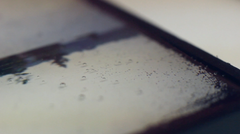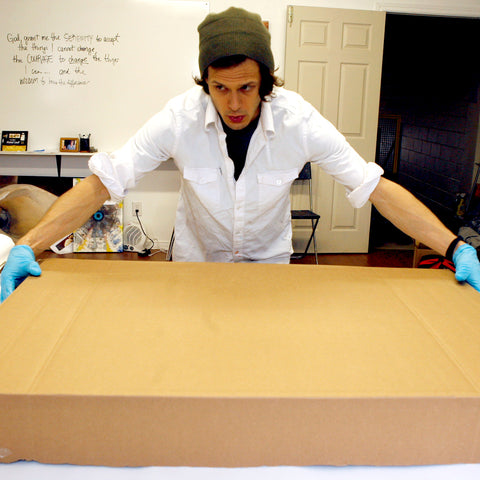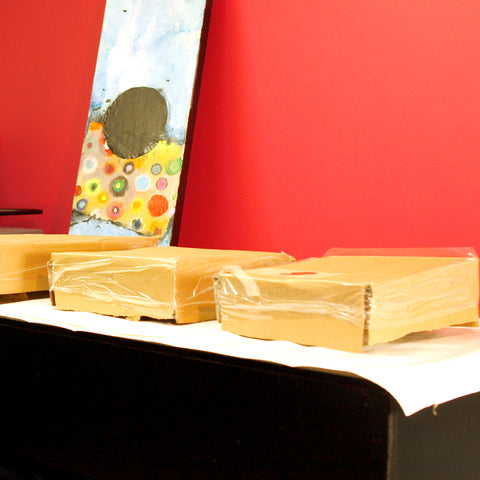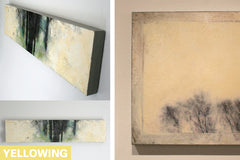How to avoid ArtResin problems
As fun and gratifying as using resin can be, it can also be frustrating if you run into issues and don't know how to solve them. Here we discuss how to avoid and fix the 5 most common issues people run into when working with epoxy resin.
If you're looking for general tips and tutorials, have a look at our YouTube videos. If you have specific questions, search our FAQ... there's a really good chance the answers you're looking for will be there!
The 5 Most Common Epoxy Resin Issues
1. Uncured, Sticky Resin
This problem usually occurs in small spots, but it can happen to an entire piece too. It is caused by the resin and hardener not catalyzing properly, which means that the two parts were either not mixed thoroughly enough, or their mixing ratio was off.
- Use fresh resin and hardener. When you purchase ArtResin online, we guarantee it to be fresh. In fact, you can find ArtResin's manufacture date on the label to make it easy to track how fresh it is! It has a shelf life of about 1 year unopened, or 6 months opened.
- Measure precisely equal amounts of the resin and hardener (ArtResin is a 1:1 ratio).
- Mix the resin and hardener thoroughly, scraping the sides and bottom of the container as you go. Stir for about 3 solid minutes. You may want to not scrape every last drip of resin out of the container, since those last bits can sometimes be improperly mixed.
- Scrape off any sticky material as best as you can and discard.
- If you are left with a deep divot or crater, patch in some new thoroughly mixed resin just in that spot.
- Next, lightly sand the entire piece (including the cured patch, if you needed a patch) and pour a second layer of resin on top. The sanding provides some tooth to the first coat so the second layer will adhere properly. It will look a mess until you pour the second layer, and then it'll look great! Obviously you need to wait until the first layer and patch are 100% cured before adding more resin on top.
2. Resin Bubbles
This an inevitable problem that is easily solved. Bubbles in resin occur as a result of mixing.

To minimize resin bubbles:
- Make sure to use a quality resin product that contains a bubble release agent, such as ArtResin. A bubble release agent allows for easy de-gassing so you don't have to really work at getting to bubbles to pop. You should be able to see the bubbles disappear just by gently blowing on them.
- Pour resin over non-porous substrates to avoid trapped air from being released into the resin. If you're resining over porous substrates such as wood or paper, sealing first is a good idea.
- Blowing on bubbles will cause them to pop, but this method is not realistic if you are coating a large piece. In this instance, use a butane or propane torch. Applying heat from these tools by quickly running them over the surface of the resin will efficiently rid the resin of bubbles. I have found a small butane torch effective for most pieces - it's easy to hold and manoeuvre, not cumbersome, and does a really good job at taking care of every last bubble. For larger pieces, a propane torch can't be beat!

3. Resin Surface Imperfections
This problem can be caused by anything floating/falling into your resin while it cures, resulting in imperfections in the surface. If you are experiencing imperfections that look more like domed bumps in the resin, skip down to #4.
To avoid imperfections:
- Resin in a well ventilated, designated resin area where your work can sit undisturbed while curing.

- Cover your work with a half cardboard box, or build a tent if your piece is very large. Prepare whatever you plan to cover with in advance so you can simply grab it and use it as soon as you're done resining.

To fix imperfections:
- Lightly sand the entire piece and re-pour a second layer of resin on top. The sanding provides some tooth on the first coat so the second layer will adhere properly. It will look a mess until you pour the second layer, and then it'll look great! Obviously you need to wait until the first layer is 100% cured before adding more resin on top.
4. Uneven or Poorly Spreading Resin
ArtResin is naturally self-levelling, so this problem happens when your work is not level or you have not used enough resin.
To avoid imperfections:
- Take the time to level your piece prior to resining. Level from left to right, and top to bottom. Use small pieces of scrap paper to even out either side to ensure levelness.

- Always mix a little more than you think you'll need to avoid running out. It's easy to find extra things to resin if you have a little left over, but not easy to mix up more if you need it considering the cure times will be different. Use our Resin Calculator to determine how much you're likely to need, then add a bit more.
- Always apply a generous amount of resin to the entire surface of your piece. Again, it's easier to do it right the first time than to have to troubleshoot a piece has cured.
To fix imperfections:
- Lightly sand the entire piece and re-pour a second layer of resin on top. The sanding provides some tooth on the first coat so the second layer will adhere properly. It will look a mess until you pour the second layer, and then it'll look great! Obviously you need to wait until the first layer is 100% cured before adding more resin on top.
5. Yellowed Resin
This issue has been greatly mitigated with our new ArtResin formula, which contains a UV stabilizer and Hindered Amine Light Stabilizer (HALS) for exceptional yellowing protection. These additives protect against yellowing caused by UV light exposure (something epoxy is prone to) at a chemistry level. It is still not recommended for outside use however, as UV light creates undesirable conditions for resin.

- Use a quality resin product that contains both a UV and more importantly a HALS stabilizer, such as ArtResin.
- Keep resined pieces out of UV light.
Read why your resin looks yellow.
Hope this helps!! Remember, as with most things in life it takes some practice and experience before getting it right. Experiment, play, learn, and enjoy the process!
Do you want to learn more about troubleshooting epoxy resin? Read our guides below:
- Tips To Prevent Bubbles
- Can I Fix Small Imperfections In My Resin?
- Is It Possible To Overstir My ArtResin?
- How Do I Remove Epoxy Resin Drips?
- Is It Possible To Over Torch My ArtResin?
- Epoxy Resin Not Hardening
- How To Prevent Bendy Resin
- How To Fix Soft, Sticky Spots In My Resin
- How Can I Avoid Getting Dimples In My Epoxy Resin?
- How To Reduce Dust Before Your Resin
- How Can I Get Rid Of Bubbles In My Cured Resin?
- How Can I Fix Dust In My Epoxy Resin?
- How Can I Deal With Epoxy Resin Drips After They've Dried?
- What Happens If I Overtorch Resin?
- Why Does My Resin Look Milky?
- Why Is My Epoxy Resin Still Sticky?
- Why Are There Bare Spots In My Cured Resin?
- What Does Silicone Do To Resin?
ArtResin: The Original Epoxy For Resin Art.


